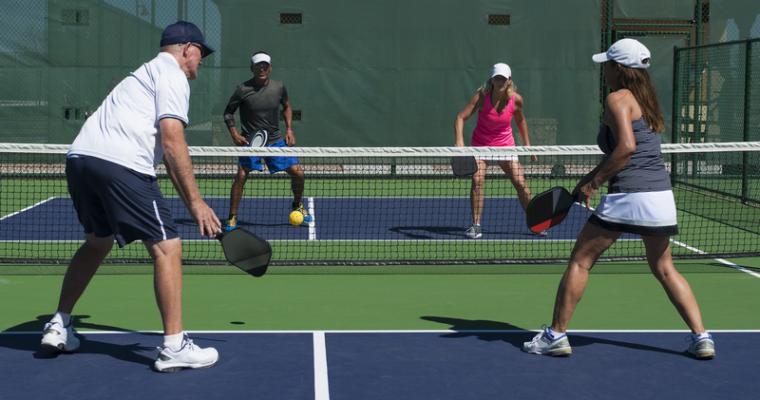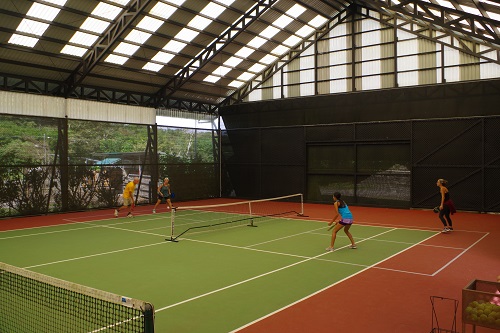

“We can’t play this game any longer, but can we still be friends?” Todd Rundgren’s 1978 smash single could be the soundtrack of the tensions today as tennis and pickleball players jockey for position on the courts. And whether those are in private clubs or municipal parks, there’s tension in the air.
The ascendancy of pickleball has created a demand for court time, annoying the “we were here first” tennis crowd. Both sports flourished in 2020 and that growth has continued into 2021; however, conflicts were apparent long before then.
In California, the Desert Sun notes, “Between the battles for open courts, debates over tape residue and verbal jabs traded at parks and recreation committees, one thing has become clear: The battle between pickleball and tennis has reached Palm Springs.”
It’s a story being repeated across the nation as cities grapple with the problem of two court sports – one rapidly growing, the other steeped in tradition – both of which need playing space. And cities can’t build fast enough to accommodate the demand. In fact, many don’t have the funds to do so.
In Fairfax, Virginia, FFXNow notes, a draft report released by the county highlights the conflict that pickleball has experienced with other recreational activities. It also provides strategies for how to minimize or eliminate problems when adding pickleball courts, especially in spaces shared with other sports like tennis and basketball.
One of the sticking points (literally) is that of playing lines. While tennis courts and pickleball courts look similar, pickleball courts are smaller and have a lower net as well as different markings. Many pickleball players are willing to overlook the net issue, at least in recreational play, but they’re marking the courts to pickleball dimensions using chalk or tape.
The chalk often breaks and leaves small pieces on the surface that can constitute a tripping hazard to players but tape also causes problems. Pulling it up can leave a sticky residue and may, after a time, be impossible to remove without damaging the court surface. In hot climates, tape can soften and glue itself down to the court surface, creating a mess for maintenance personnel.
In Palm Springs, Vicki Oltean, director of the Palm Springs parks and recreation department, described the scene at Ruth Hardy Park as a weekend “takeover,” with players taping off lines and bringing their own nets. She said tennis players’ shoes were getting stuck on the tape residue, which she said was technically defacing city property. (A USA Pickleball official refuted this report, and added that without delineating the playing area, there would not have been enough courts to accommodate the number of players).
Wilton (Connecticut) Parks and Recreation was forced to step into the fray in their town after pickleball players drew playing lines in chalk on Wilton High School’s tennis courts, according to Good Morning Wilton; at the time, the courts had just been resurfaced. The crooked makeshift lines sent tennis court players’ tempers through the roof and complaints reached the ears of first selectwoman Lynne Vanderslice, who took to Facebook to remind all players the courts were for one sport only: tennis.
There are other sources of friction, however. Pickleball paddles and balls make a different sound from the one tennis players are using, another cause for complaints among players. State College, Pennsylvania had pickleball courts adjacent to the tennis courts; however, after noise complaints from tennis players, Patton Township agreed to relocate the courts, noted reporters in an article for Centre Daily.
In some places, the mere suggestion of lining courts for pickleball (even professionally) irritates players. Maui’s tennis community is one such place, according to the Maui News. Unfortunately, the article noted, there are limited funds to build new courts and few acceptable sites (many were in poor condition and others were deemed too windy; because pickleballs are hollow plastic, wind wreaks havoc on a game). It seems, therefore, for the time being, sharing courts will have to continue.
The tennis community opposed the encroachment of pickleball (known in Hawai’I as pukaball) onto Maui’s tennis courts, claiming damage to the surface of current courts and decrying the confusion with overlapping court lines, noise intrusion and nets being lowered to pickleball height but not returned to tennis height.
In many cases, it goes back to a philosophy that can be summed up in four words: We were there first.
“We need to come together as a community, work together rather than provoking anger and dividing the community by pushing to convert tennis courts to pickleball courts,” said Pearl Rocket, who has been playing tennis for 35 years. “I do not oppose the sport, but I strongly oppose tennis courts being converted to pickleball courts. Not now, not ever.”
Another problem with court-shares has been the fact that with school back in session, tennis teams will need practice and play space, squeezing usage still further. And damage to the surface can impact games and force cancellations. At clubs, tennis leagues, lessons and classes in Cardio Tennis can also increase demands for court time.
Pickleball player (and USA Pickleball ambassador) Fellow Laurie Loney says she has “no desire to fight with the tennis community.”
“I played tennis competitively for almost all my life and I love tennis,” Loney said. “This is not just a problem on Maui, but all over the country with pickleball versus tennis.”
In many cities, courts are lined for both sports (in different colors, to alleviate confusion) and league play, as well as recreational play, is scheduled at specific times. Many areas have pickleball-specific facilities as well as tennis-specific facilities.

